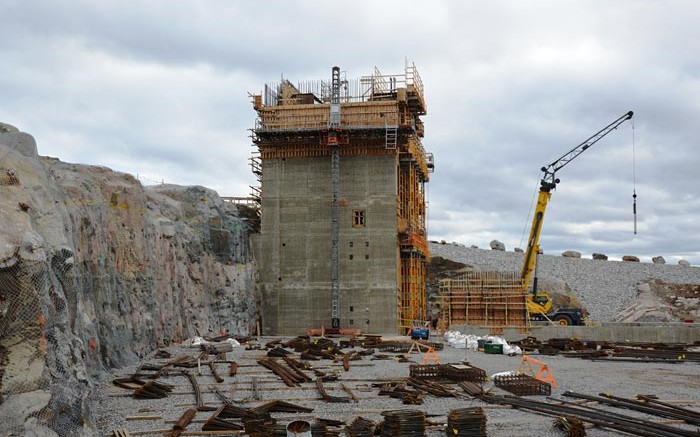Stornoway Diamond (TSX: SWY; US-OTC: SWYDF) is halfway through building its Renard diamond mine in Quebec — the first diamond mine in the province, and one of only two currently being built in Canada — but already the project is showing that an extended mine life might be possible.
Results from a drill campaign late last year suggest that more resources could extend Renard’s mine life beyond the 11 years outlined in a 2013 feasibility study.
The company says there is exploration potential at the Renard 2 and Renard 3 kimberlite pipes at a depth of 1,250 metres, where both kimberlites could have sizable widths and remain open.
Drilling has shown that while Renard 2 has a smaller cross section at 600 metres deep than the company expected, it continues to a depth and scale that makes it “unique” among Canadian kimberlites, president and CEO Matt Manson says.
“What is remarkable about Renard 2 is that at 1,000 metres deep, we’re still drilling through a sizable orebody — something that we’ve established is between 0.62 and 1.38 … we had one drill hole that after exiting Renard 2 went back into kimberlite at 1,000 metres deep, and went for 120 metres of kimberlite intersection — and then we lost the hole,” he says. “But that intersection on a horizontal basis is 47 metres across, and we realized that the intersection was actually from Renard 3. We had rediscovered Renard 3 at 1,000 metres. Now we have it at 1,000 metres and at almost twice the size than it was higher up … we don’t know where Renard 3 is going, so now we’ll chase that.”
For the first time, Stornoway has incorporated more than 4 million tonnes of lower-grade country rock breccia (CRB) from Renard 2 into the indicated category. “There is CRB at the top of the kimberlite that forms a big, high-tonnage halo that wraps around the kimberlite,” Manson explains. “The material is a highly diluted breccia that surrounds the kimberlite and forms part of the kimberlite emplacement event, and it has diamonds in it, but at a lower grade of 21 carats per hundred tonnes … and by way of reference, that grade would be high-grade material in the context of an African mine, although it’s lower grade in the Canadian context.
“We knew the stuff was there and that it had diamonds in it, and most of the 4 million tonnes is in the pit, and we’re already paying to take it out, it’s part of the stripping waste,” he says. “It also represents a large part of the mining dilution that we expect to incur in the underground mine. Now that we’ve got a big enough data set to convert it from inferred to indicated, we can talk about it as incremental production.”
The latest drill results have increased Renard’s total indicated resource by 11% to 30 million carats, and the company will incorporate the numbers into an updated mine plan. (Inferred resources stand at 13.35 million carats, and the company has classified another 27.8 million carats to 58.7 million carats as non-resource exploration upside.)
Located 350 km north of Chibougamau in the James Bay region of north-central Quebec, Renard is fully financed and permitted for developing an open-pit and underground diamond mine.
The operation could produce an average of 1.6 million carats a year (representing 2% of global diamond supply by value) at US$190 per carat, based on an assessment in March 2014 by WWW International Diamond Consultants.
Stornoway is on schedule to commission the plant in the second half of 2016, with commercial production to follow in the second quarter of 2017, and full production in mid-2017.
Prestripping at Renard 2 and Renard 3 kicked off in March, with concrete-pouring on major facilities in April. By the end of July, the company had developed 500 metres of the underground mine.
“We’re the only major mine under construction in Eastern Canada,” Manson says, “and our ability to keep it on budget and on schedule [is based on] building it in a downcycle. We have the first pick of suppliers and we have the first pick of contractors.”
Stornoway says total construction costs could come to $811 million, including all direct and indirect costs, escalation and contingency.
The processing plant will operate at 6,000 tonnes per day, or 2.2 million tonnes per year, but could expand to 7,000 tonnes per day, or 2.6 million tonnes per year.
The mine will be powered with liquefied natural gas generators.
According to an optimized 2013 feasibility study and based on 17.9 million reserve carats, Renard’s after-tax net present value at a 7% discount rate works out to $391 million, with a 16.3% after-tax internal rate of return.
Renard will be Canada’s first diamond mine with year-round road access, which will help lower costs, reduce operating risk and develop lower grade material later in its mine life. The road was developed between 2011 and 2014, under the auspices of Quebec’s Plan Nord.
As for mining in Quebec, Manson says, it’s “a terrific jurisdiction for doing business, and we’ve always had great institutional support in the province.”


Be the first to comment on "Stornoway’s resource rises at Renard"